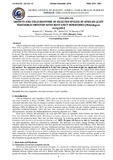Growth and yield response of selected species of African leafy vegetables infested with root knot nematodes (meloidogyne incognita)

View/
Date
2014Author
Kimaru, SL
Kimenju, JW
Kilalo, DC
Onyango, CM
Language
enMetadata
Show full item recordAbstract
African indigenous leafy vegetables (AILVs) are an important commodity in the diet of many African communities.
Most of the vegetables are grown by low-income small holder farmers and thus, play a crucial role in food security and in
improving the nutritional status of poor families. However, root knot nematodes are a major hindrance to production with
yield losses of 80 to 100 percent being recorded on some of the vegetables depending on susceptibility and inocula levels
in the soil. The objective of this study was to investigate the effect of root knot nematodes on the growth and yield of
popular AILVs. A greenhouse experiment was conducted twice, where AILVs namely spider plant (Cleome gynandra),
amaranthus (Amaranthus hybridus), African night shade (Solanum nigrum), cowpea (Vigna unguiculata), jute mallow
(Corchorus olitorius) and sun hemp (Crotalaria juncea) were tested. The seeds for each vegetable were planted in six
pots out of which three of the pots were infested with 2000 second stage juveniles of root knot nematodes and data on
plant height, fresh and dry shoot weight, galling index, egg mass index and the second stage juvenile count was recorded
and analyzed. The experiment was terminated at 60 days after planting. Fresh shoot weight was significantly (P≤0.05)
different among the different AILVs which were infected by the root knot nematode. The highest fresh shoot weight
reduction was recorded in cowpeas (26.2%), African night shade (21.9%) and jute mallow (19.3%) lower in inoculated
compared to the non- inoculated plants. The lowest fresh shoot weight reduction was recorded in spider plant (5.3%), sun
hemp (5.2%) and Amaranths (6.7%) compared to the non-inoculated plants. On a scale of 1-10, where 1 = resistant and
10 = most susceptible, galling index was 1.7 in amaranths and 7.0 in the African night shade. Spider plant, sun hemp and
amaranths had galling indices of 3, 2 and 1.7 respectively and were rated as resistant while jute mallow, cow pea and
African night shade had galling indices of 6.7, 6.3 and 7 respectively and were rated as susceptible. The identified
resistant varieties can be used as intercrops/rotation crops in agricultural production systems as a component of root knot
nematode suppression in the soil.
